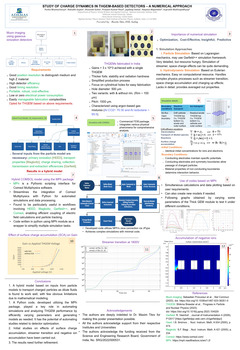23. Study of Charge Dynamics in THGEM-based Detectors – A Numerical Approach
ID:7
Submission ID:7 View Protection:ATTENDEE
Updated Time:2024-10-11 14:11:37
Hits:493
Poster Presentation
Abstract
Muography is a method for scanning a target object by analyzing how it interacts with muons. Indeed, the interaction mode depends on the energy of the incident muon, as well as the characteristics of the medium participating in the interaction. Electromagnetic interaction between cosmic muons and the atoms of the target object causes the trajectories of cosmic muons to deviate before reaching some of the position sensitive particle detectors used to image the target. The characteristic features of the material determine the magnitude of the deviation. The track deviations are then used as a body of information to generate images and predict the target’s material composition and geometry. Position-sensitive detectors placed at suitable locations all around the target can be used to monitor the incoming and outgoing muons. Detectors based on THick Gaseous Electron Multipliers (THGEM) are likely to satisfy the necessary requirements and a detailed numerical study has been carried out in this work to qualify their performance.
To employ THGEM for imaging purposes, study of detector parameters like efficiency, gain, gain uniformity, space charge, discharge probability etc. are crucial, especially for long term and consistent operation of the detector. All these phenomena, in their turn, depend on the dynamics of charged particles within the device. Because of the large number of particles involved and their complex interactions, the dynamic processes of generation and loss of charged particles, and their transport within the detector volume are extremely expensive to simulate numerically.
We have proposed a hybrid fast numerical model to estimate the response, charge dynamics of avalanche and streamer / discharges of THGEM-based ionization detectors. Information related to primary ionization is obtained from HEED, while all the transport properties are evaluated using MAGBOLTZ. The transport is simulated following hydrodynamic model using COMSOL that solves the electrostatics problem with space charge using Electrostatics (ES) from the AC/DC module, and the dynamics of charged particles by the Transport of Dilute Species (TDS) of the Chemical Reaction Engineering (CRE) module. The effective gain estimated from the simulation has been compared with the available experimental data and good agreement is observed. Positive streamers or discharges driven by ionic space charges have been observed. Since the hydrodynamic model is deterministic in nature, sources of fluctuations have been introduced in terms of different possible combination of initial conditions. Initial number of primaries, position and configuration of the seed cluster are found to have significant impact on the subsequent development of detector response. It may be mentioned here that variation of all these model parameters and their resulting outputs have been managed in a seamless manner with the help of a python interface, without the monotonous and repeated intervention of a human user.
In this presentation, we propose and evaluate possible algorithms / approaches that show some promise in relation to the above-mentioned problems. Effect of different simulation parameters will also be demonstrated using simple examples. Particle model of charge transport using Garfield++ will also be used to address some of the problems to appreciate the advantages and disadvantages of these two approaches presently available for particle detector simulation.
Keywords
THGEM, charge dynamics, avalanche, streamer, simulation, COMSOL, Garfield++, python interface
Submission Author
Purba Bhattacharya
Adamas University
Supratik Mukhopadhyay
Saha Institute of Nuclear Physics
Nayana Majumdar
Saha Institute of Nuclear Physics;A CI of Homi Bhabha National Institute
Rishabh Gupta
Adamas University
Shounok Guha
Adamas University
Prasant Kumar Rout
National Central University, Taiwan
Jaydeep Datta
Stony Brook University




Comment submit